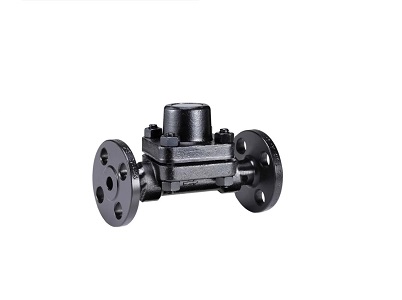1. When the equipment is started, air enters the trap, and at low temperature, the valve core is in the open position.
2. After the condensed water enters the trap, at low temperature, the temperature-sensitive liquid in the diaphragm element is still condensing, the valve core is fully opened, and the condensed water is discharged immediately.
3. Condensed water enters the trap. As the temperature rises, the temperature-sensitive liquid inside the diaphragm element begins to evaporate and expand. As internal pressure increases, the diaphragm moves the spool in the closing direction. Before the temperature reaches the saturation temperature, the slide valve closes the valve completely.
4. After the hot condensed water accumulated in the valve cools down slowly, the diaphragm will shrink due to the decrease in internal pressure, the valve core will open the valve, and the condensed water will continue to be discharged. The reason why the valve is formed is that there is always hot condensed water in front of the valve, the steam and water are separated, and there is no steam leakage.
Selection Procedure for Bimetallic Steam Traps
1. Select the pressure (temperature resistance) capacity according to the working steam pressure;
2. Determine the configuration of the heat exchanger: jacket heat exchanger, shell and tube heat exchanger, plate heat exchanger, unit heat exchanger, etc.;
3. Determine the heating method: intermittent or continuous;
4. Calculate the heat transfer area, and then calculate the displacement;
5. Select the valve type: mechanical type, thermostat type, thermodynamic type (disc),
6. Calculated according to the working pressure difference in the working environment,
7. Model selection,
8. Choice of installation method: vertical, parallel, etc.
Bimetallic steam traps shall meet the following requirements.
1. The bimetallic steam trap should be installed near the heating equipment or pipeline, below the condensate outlet for easy maintenance. If you move too far from the drain point, air and steam can collect in the valve's headpipe, closing off the bimetal trap and blocking the flow of condensate.
2. The bimetal steam trap body should be installed vertically without tilting to prevent steam and drain, so that the medium flows in the same direction as the marked body*.
3. When assembling the bimetallic steam trap, please set up the bypass pipe, flushing pipe, test pipe, check valve and filter, and install the necessary flanges or unions to facilitate maintenance and disassembly.
4. Stop valves must be installed before and after the bimetallic steam trap to facilitate the maintenance and closure of the bimetallic steam trap. This valve is not required if the condensate can be recycled.
5. A filter must be installed between the bimetal steam trap and the front check valve to prevent the dirt in the water from clogging the bimetal trap (the thermodynamic bimetal trap comes with a filter).
6. The flushing pipe is installed in front of the valve group, which can flush and discharge air during the initial operation of the system, thus preventing blockage and damage to the bimetallic valve.
7. Install a test tube between the bimetal steam trap and the back shut-off valve to check the working condition of the bimetal steam trap. If a large amount of vapor is released from the tube, the bimetallic trap has lost its vapor barrier function and needs to be repaired or replaced.
8. Set the bypass pipe that is mainly used to discharge a large amount of drainage when the system starts to operate. It is not appropriate to open a bypass branch due to maintenance of a bimetallic steam trap. This allows steam to enter the return system, thereby affecting the balance of other heating equipment and the return pressure of the pipe network. Usually there is no need to install bypass pipes, because practice has proved that bypass pipes are more harmful and less profitable. For production heating equipment that requires continuous production and strict heating temperature requirements, a bypass pipe must be installed.

 WENZHOU WEITUO VALVE CO., LTD.
WENZHOU WEITUO VALVE CO., LTD.